by Lauren Kramer
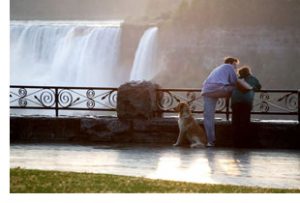 Niagara Falls has inspired generations with romance, Valentine’s Day, or no.
Niagara Falls has inspired generations with romance, Valentine’s Day, or no.
There was a time when this city was cheesy beyond belief, replete with motels advertising red, heart-shaped hot tubs and tacky attractions. A few of those attractions remain, but Niagara Falls has witnessed a renaissance of sorts since the Fallsview Casino Resort opened four years ago.
That’s meant the introduction of new spas at hotels and a general up-scaling of the offerings, according to Betsy Foster, media and marketing coordinator for Tourism Niagara.
One thing that hasn’t changed over time is the sense of wonder that overwhelms you as you gaze at 600,000 gallons of water spilling 167 feet over the falls with every passing minute.
It’s the kind of sight that makes you reach for your partner’s hand and cherish the feeling of vulnerability and awe with someone close by your side. And it’s a spectacle that has the power of perspective, for in witnessing the mesmerizing falls, other worries fade to the background.
Perhaps that’s the reason honeymooners have flocked to Niagara Falls for decades, enchanted and inspired by its beauty and fearsomeness, and its ability to quell the mind of doubts and distractions.
Amid the deafening roar of vast quantities of water plummeting over a precipice, they obtain a focus of sorts, one that hints at the incredible power and timelessness of nature, the comparative smallness of humanity and the urgent need to seize the moment and live the day to its fullest.
 Among the 11 million annual visitors to Niagara Falls, 50,000 are honeymooners, who are rewarded with discounts aplenty from local businesses and honeymoon certificates from the tourism bureau.
Among the 11 million annual visitors to Niagara Falls, 50,000 are honeymooners, who are rewarded with discounts aplenty from local businesses and honeymoon certificates from the tourism bureau.
Romantic celebration is intrinsic to Niagara Falls, an almost tangible quality that’s evident in the dreamy gaze of fall-watchers, the abundance of couples utterly absorbed in their togetherness and the plethora of romantic opportunities.
In summer, you can feel the water soak your hair on the Maid of the Mist, a cruise that takes you past the American Falls and into the mist of the Horseshoe Falls, where you emerge damp and yet strangely invigorated.
There are aerial cable cars, walks along the Gorge rapids and journeys behind the falls, where you descend into their base by elevator, following a series of tunnels behind and under the Horseshoe Falls for a unique glimpse.
The tacky side of Niagara is good for a breezy, laughter-filled afternoon, and can be found in an area known as Clifton Hill. Here, the Movieland Wax Museum of Stars rubs shoulders with the Criminal Hall of Fame, Ripley’s Moving Theatre, the Funhouse and the Haunted House.
The Great Canadian Midway is a complex containing rides, restaurants, sports simulators and more, but for a more flighty experience, visit the Bird Kingdom, a massive aviary home to over 500 birds from all over the world.
 One way to experience the view is from a heated gondola on the Niagara SkyWheel, a 53-meter-high Ferris wheel that sweeps visitors to the summit for breathtaking views of the falls.
One way to experience the view is from a heated gondola on the Niagara SkyWheel, a 53-meter-high Ferris wheel that sweeps visitors to the summit for breathtaking views of the falls.
Another is to visit the Imax theatre on Fallsview boulevard, where you get an historical overview of the Falls, a seasonal perspective and a sense of the power of the water, as helicopter footage takes you virtually over the edge.
A few people a year discover what this actually feels like, – some in acts of suicide, while others attempt to ride the precipice of the falls for a thrill, hoping to live. Since 1901, more than two dozen people have challenged the falls, a handful of whom survived.
One daredevil to live accomplish this feat twice was Dave Munday, an Ontario man who first made it over the falls in a barrel and later in a diving bell. Though sustaining cuts, bruises and unconsciousness at the time, he is still alive and kicking.
Another recent attempt was made by Jessie Sharp, who went over the falls in a kayak in 1990. His body was never found and it is presumed he drowned. For those that survive, though, the price of fame comes with a hefty fine – as much as $500. “It’s against the law and we don’t encourage it,” says Foster.
For most people, it suffices to imagine briefly what such a ride might feel like. The euphoria from visiting the falls comes from viewing their power and majesty, and not in taking a leap over the edge.
The good news is that a quick Valentines jaunt into Niagara Falls doesn’t have to cost a fortune.
Romance packages are standard year-round in this neck of the woods, and the Sheraton Fallsview Hotel & Conference Centre (www.fallsview.com; (800) 618-9059), one of the city’s high-end hotels that overlooks the falls, offers a romance package for $259, which includes a night’s accommodation for two, a bottle of wine, a $75 voucher towards dinner for two and breakfast.
About the author:
This week Traveling Tales welcomes freelance travel writer Lauren Kramer who makes her home in Richmond, a suburb of Vancouver B.C.
If You Go:
For more information, visit www.discoverniagara.com or call (800) 563-2557
Tickets to the Imax cost between $20 and $14, with discounts available for online bookings at www.imaxniagara.com (866) 405-IMAX
Maid of the Mist ( www.maidofthemist.com) costs $14 for adults and $8.60 for kids age 6-12. There are no advance reservations and the sailings occur daily April through November.
Photos courtesy of Niagara Tourism:
1: Romance is in the air at The Falls.
2: Families enjoy one of the many beautiful parks..
3: Visitors are thrilled with dramatic close-ups.
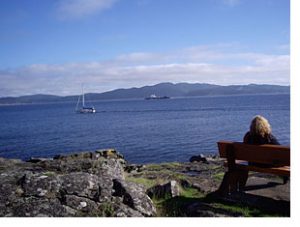
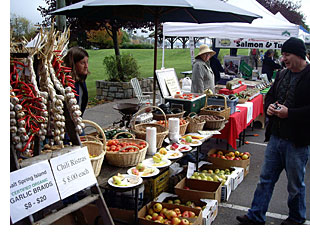 Every Saturday morning from April to October over a hundred artisans and farmers congregate to sell their goods. Tables, shaded by colourful umbrellas, border the parkway and host everything from bead work to bokchoy.
Every Saturday morning from April to October over a hundred artisans and farmers congregate to sell their goods. Tables, shaded by colourful umbrellas, border the parkway and host everything from bead work to bokchoy.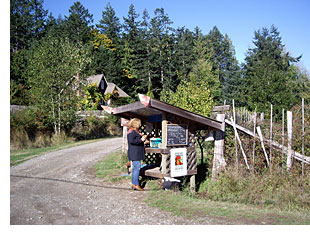 The string of bargains and vendor stalls carry on after we leave the market place. Roadside stands dot the hillsides on our island drive and brim over with everything from bright floral bouquets to the garden’s daily pick. Most are unmanned, and operate by a trustworthy honor system -a refreshing change from our commercialized big box stores!
The string of bargains and vendor stalls carry on after we leave the market place. Roadside stands dot the hillsides on our island drive and brim over with everything from bright floral bouquets to the garden’s daily pick. Most are unmanned, and operate by a trustworthy honor system -a refreshing change from our commercialized big box stores!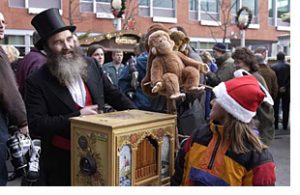
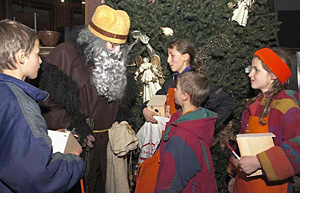 As the crowd files into the square, the opening ceremonies begin: songs, speeches and performances. And then the Christmas lights decorating the building, the Christmas tree and the square are turned on to cheers and exclamations of delight. The Christkindl Market has officially opened!
As the crowd files into the square, the opening ceremonies begin: songs, speeches and performances. And then the Christmas lights decorating the building, the Christmas tree and the square are turned on to cheers and exclamations of delight. The Christkindl Market has officially opened!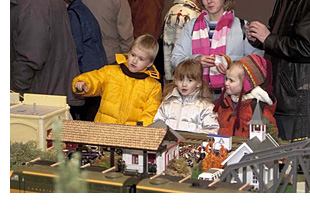 It’s a great way to buy truly unique gifts for everyone on my list. I select a hand-crafted necklace from one stall, while a nearby toddler watches in fascination as a toymaker demonstrates the intricate mechanisms of his wares—carved wooden figurines that evoke days long past. A few moments later, I know exactly how the toddler feels, as I find a table of Fabergé-style eggs, each gilt-encrusted orb concealing its own little wonder.
It’s a great way to buy truly unique gifts for everyone on my list. I select a hand-crafted necklace from one stall, while a nearby toddler watches in fascination as a toymaker demonstrates the intricate mechanisms of his wares—carved wooden figurines that evoke days long past. A few moments later, I know exactly how the toddler feels, as I find a table of Fabergé-style eggs, each gilt-encrusted orb concealing its own little wonder.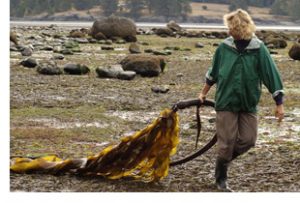
 Her terrain is the beach just beyond the Sooke Harbour House, alongside a narrow stretch of land that twists like a dog’s tail into the ocean. The area is straight out of a west coast fairy tale, from its very name, Whiffen Spit, to the white clapboard house that is Sooke Harbour House, with the acres of edible flowers that trim its perimeter.
Her terrain is the beach just beyond the Sooke Harbour House, alongside a narrow stretch of land that twists like a dog’s tail into the ocean. The area is straight out of a west coast fairy tale, from its very name, Whiffen Spit, to the white clapboard house that is Sooke Harbour House, with the acres of edible flowers that trim its perimeter.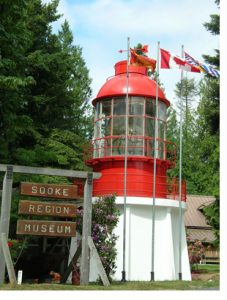 Braving about 100 bee stings a year, Liptrot turns some of his honey into mead, the dessert wine most often referred to in the works of Shakespeare and Chaucer. The mead is a deliciously different alcoholic beverage, and Tugwell Creek’s varieties are hard to come by unless you stop in at the farm or visit the smattering of wine shops in BC that carry this product.
Braving about 100 bee stings a year, Liptrot turns some of his honey into mead, the dessert wine most often referred to in the works of Shakespeare and Chaucer. The mead is a deliciously different alcoholic beverage, and Tugwell Creek’s varieties are hard to come by unless you stop in at the farm or visit the smattering of wine shops in BC that carry this product.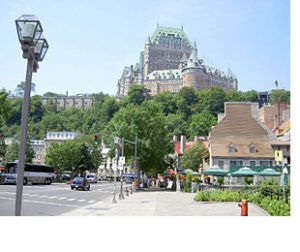
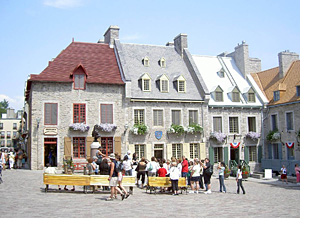 A small part of the old city known as Basse-Ville or Lower Town, next to the river, is the oldest quarter in the city, filled with impressive renovated old structures from the 1600s and 1700s. It was here where Samuel de Champlain founded New France in 1608. Basse-Ville lies outside the walls, between the base of the cliff and the river, and has a good number fine shops and restaurants. Stairways lead down to Basse-Ville from the bluff, but an easier way to go is the renovated funicular – a glass elevator sliding up and down a ramp that has been in use since 1879.
A small part of the old city known as Basse-Ville or Lower Town, next to the river, is the oldest quarter in the city, filled with impressive renovated old structures from the 1600s and 1700s. It was here where Samuel de Champlain founded New France in 1608. Basse-Ville lies outside the walls, between the base of the cliff and the river, and has a good number fine shops and restaurants. Stairways lead down to Basse-Ville from the bluff, but an easier way to go is the renovated funicular – a glass elevator sliding up and down a ramp that has been in use since 1879.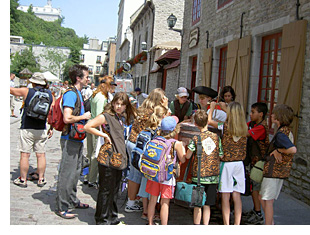 The Museum of French America, noted for its stunning chapel. The Museum of Québec; an architectural master piece, is one of Québec’s most important museums, containing an extensive collection of Québécois art and historical documents.
The Museum of French America, noted for its stunning chapel. The Museum of Québec; an architectural master piece, is one of Québec’s most important museums, containing an extensive collection of Québécois art and historical documents.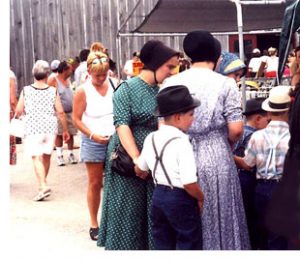
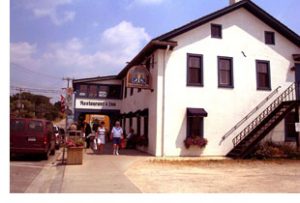 Eby Street is a well-traveled thoroughfare, the William W. Snyder House, built in 1898—now re-named Jakobstettel Guest House—is an elegant Queen Anne style mansion, while the Steiner House built around 1857, is a four-square Georgian building fronting on King Street. (In the course of recent renovations, a child’s shoe was discovered buried in the wall – a good luck charm, according to an old German belief.)
Eby Street is a well-traveled thoroughfare, the William W. Snyder House, built in 1898—now re-named Jakobstettel Guest House—is an elegant Queen Anne style mansion, while the Steiner House built around 1857, is a four-square Georgian building fronting on King Street. (In the course of recent renovations, a child’s shoe was discovered buried in the wall – a good luck charm, according to an old German belief.)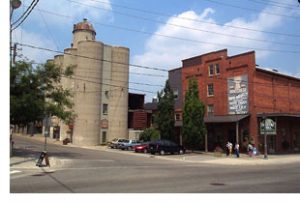 Established by Elias W.B Snider in 1870, this was the first mill in Canada to export its prime quality flour to Glasgow, Liverpool and Belfast. Today the silos have been converted into an unusual retail outlet for the Village’s gifted craftspeople, and as a showcase for exquisite collections of crystal ornaments, brass lamps, jewelry, leatherwork, quilts, pottery and glass-blown objects d’art.
Established by Elias W.B Snider in 1870, this was the first mill in Canada to export its prime quality flour to Glasgow, Liverpool and Belfast. Today the silos have been converted into an unusual retail outlet for the Village’s gifted craftspeople, and as a showcase for exquisite collections of crystal ornaments, brass lamps, jewelry, leatherwork, quilts, pottery and glass-blown objects d’art.

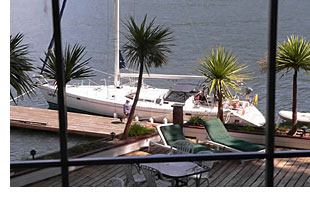 We could have kayaked. Or fished. Or even twisted through a yoga encounter. And Sally kayaked. I chose to read. We could have hiked, gone up the inlet to see the whales or the bears. Or we could have enjoyed the hot tub. Sally went hiking. I napped. We could have joined Mark on a Nature walk or cooked in the kitchen with Abby. Sal cooked. I chose to sip wine and watch the boats go by. Rendezvous Lodge has so many interests to pursue and sights to see, I decided that contemplation was the better part of valour. And I don’t regret a second of it.
We could have kayaked. Or fished. Or even twisted through a yoga encounter. And Sally kayaked. I chose to read. We could have hiked, gone up the inlet to see the whales or the bears. Or we could have enjoyed the hot tub. Sally went hiking. I napped. We could have joined Mark on a Nature walk or cooked in the kitchen with Abby. Sal cooked. I chose to sip wine and watch the boats go by. Rendezvous Lodge has so many interests to pursue and sights to see, I decided that contemplation was the better part of valour. And I don’t regret a second of it. Surprisingly, and despite the remoteness, despite the distance and the various modes of transportation, it all worked out and it all worked out easily. You can travel quickly and efficiently or you can take your time and languidly explore the area. It is hard to imagine a better way to spend a few days.
Surprisingly, and despite the remoteness, despite the distance and the various modes of transportation, it all worked out and it all worked out easily. You can travel quickly and efficiently or you can take your time and languidly explore the area. It is hard to imagine a better way to spend a few days.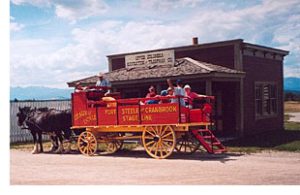
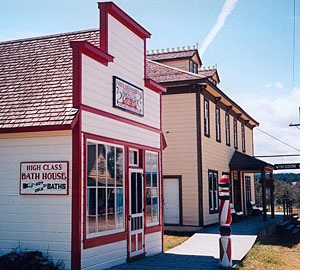 At Howard House millinery shop, we admire fetching brimmed hats elaborately decorated with gaudy fruits or elegant ostrich plumes and satin ribbons. We find the barbershop fronted by universal red and white poles, stage and express office, livery stables and government building, all remarkably restored. Period furnishings, wallpapers, artifacts and memorabilia are placed just as they might have been during the town’s hey-day.
At Howard House millinery shop, we admire fetching brimmed hats elaborately decorated with gaudy fruits or elegant ostrich plumes and satin ribbons. We find the barbershop fronted by universal red and white poles, stage and express office, livery stables and government building, all remarkably restored. Period furnishings, wallpapers, artifacts and memorabilia are placed just as they might have been during the town’s hey-day. Away from the river, weathered Scandinavian-designed houses exemplify turn-of-the- century homes. Thriving heritage gardens cluster around the doctor’s house and the vicarage; a group of residences sporting white lace curtains and railed porches back onto Opera House Street.
Away from the river, weathered Scandinavian-designed houses exemplify turn-of-the- century homes. Thriving heritage gardens cluster around the doctor’s house and the vicarage; a group of residences sporting white lace curtains and railed porches back onto Opera House Street.
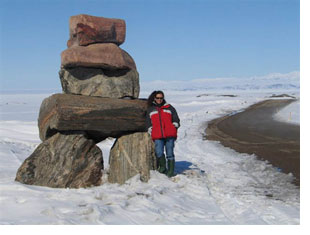 It was evening in the town of Pond Inlet when our flight landed, and though a heavy fog obscured the view, night could not have been further away. By late May, Nunavut has surrendered to 24-hour days, confusing the mind and body with sunshine even at 11pm.
It was evening in the town of Pond Inlet when our flight landed, and though a heavy fog obscured the view, night could not have been further away. By late May, Nunavut has surrendered to 24-hour days, confusing the mind and body with sunshine even at 11pm.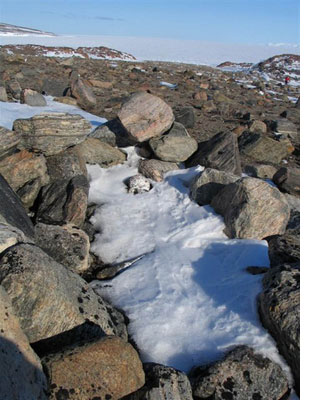 “This is a harsh land,” cautions Parks Canada in its literature to visitors of Sirmilik National Park. “Rescue facilities and services are very limited…and may make rescue entirely impossible. You must be prepared for self-rescue.”
“This is a harsh land,” cautions Parks Canada in its literature to visitors of Sirmilik National Park. “Rescue facilities and services are very limited…and may make rescue entirely impossible. You must be prepared for self-rescue.”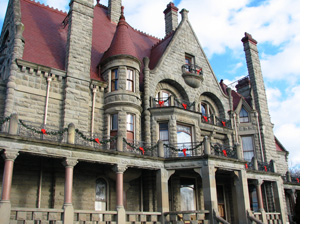 I am standing at the entrance to a splendid castle, its fireplace decorated with boughs of mistletoe and ivy, its hallway aglow with lights, and its grand staircase banisters wreathed in garlands of holly. The rich aroma of stuffed roast goose in a sage and onion gravy draws me to the dining room where distinguished guests exchange animated conversation across a table set in elegant style. The women wear silk gowns, their diamond necklaces winking in the light of candelabra centrepieces; the men sport mutton-chop moustaches and side-burns, and sip mulled wine from crystal goblets. A child’s laughter echoes faintly from one of the upstairs rooms. The ghosts of Christmases past still linger in the rooms of Craigdarroch Castle in Victoria, and although these guests at their Christmas banquet are figments of my imagination, the castle still celebrates this most joyous of all seasons by donning a mantle of dazzling Yuletide finery.
I am standing at the entrance to a splendid castle, its fireplace decorated with boughs of mistletoe and ivy, its hallway aglow with lights, and its grand staircase banisters wreathed in garlands of holly. The rich aroma of stuffed roast goose in a sage and onion gravy draws me to the dining room where distinguished guests exchange animated conversation across a table set in elegant style. The women wear silk gowns, their diamond necklaces winking in the light of candelabra centrepieces; the men sport mutton-chop moustaches and side-burns, and sip mulled wine from crystal goblets. A child’s laughter echoes faintly from one of the upstairs rooms. The ghosts of Christmases past still linger in the rooms of Craigdarroch Castle in Victoria, and although these guests at their Christmas banquet are figments of my imagination, the castle still celebrates this most joyous of all seasons by donning a mantle of dazzling Yuletide finery.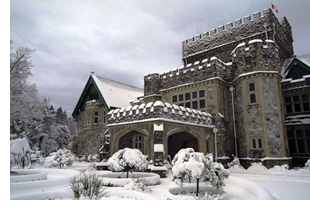 Craigdarroch Castle was completed in 1890 by coal baron Robert Dunsmuir, who spared no expense in furnishing his stately mansion with exquisite stained glass windows, oil paintings, and lavish Victorian furnishings. The family history, depicted in photos, memorabilia and information panels in the Exhibit Room on the second floor traces the lives of Robert and Joan Dunsmuir, their ten children and some of their grandchildren. The Dunsmuir progeny for the most part, however, seem to have been lonely, neurotic individuals, cursed rather than blessed by their inheritance.
Craigdarroch Castle was completed in 1890 by coal baron Robert Dunsmuir, who spared no expense in furnishing his stately mansion with exquisite stained glass windows, oil paintings, and lavish Victorian furnishings. The family history, depicted in photos, memorabilia and information panels in the Exhibit Room on the second floor traces the lives of Robert and Joan Dunsmuir, their ten children and some of their grandchildren. The Dunsmuir progeny for the most part, however, seem to have been lonely, neurotic individuals, cursed rather than blessed by their inheritance.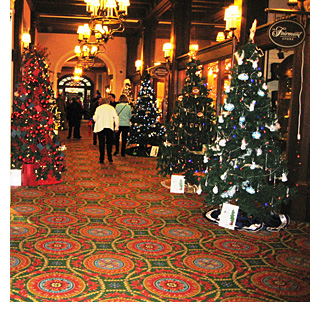 Leaving Victoria’s past and returning to its present, I stroll through the corridors of the Empress Hotel to admire sixty or more exquisitely decorated Christmas trees which are part of their annual Festival of Trees celebration. Sponsored by local businesses and organizations, to raise funds for the B.C. Children’s Hospital, it is a fitting commemoration of the Child born in Bethlehem and His ageless message of love and compassion.
Leaving Victoria’s past and returning to its present, I stroll through the corridors of the Empress Hotel to admire sixty or more exquisitely decorated Christmas trees which are part of their annual Festival of Trees celebration. Sponsored by local businesses and organizations, to raise funds for the B.C. Children’s Hospital, it is a fitting commemoration of the Child born in Bethlehem and His ageless message of love and compassion.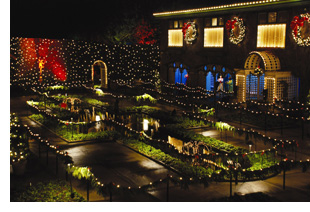 But the evening isn’t over yet. Before boarding our limo under the gaze of twelve drummers marching overhead, our hosts from the Inn at Laurel Point offer us a choice of hot chocolate or eggnog beverages. I lift a mug of steaming hot, satiny smooth eggnog, laced with an out-of-this-world combination of rum and spices, and drink a toast to Victoria’s ghosts of Christmases past, and to its magical spirit of Christmas present.
But the evening isn’t over yet. Before boarding our limo under the gaze of twelve drummers marching overhead, our hosts from the Inn at Laurel Point offer us a choice of hot chocolate or eggnog beverages. I lift a mug of steaming hot, satiny smooth eggnog, laced with an out-of-this-world combination of rum and spices, and drink a toast to Victoria’s ghosts of Christmases past, and to its magical spirit of Christmas present.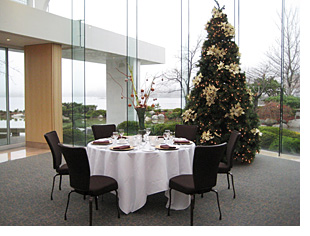 The Inn at Laurel Point is the epitome of luxury and attentive personalized service.
The Inn at Laurel Point is the epitome of luxury and attentive personalized service.